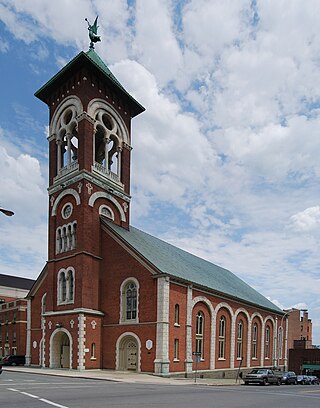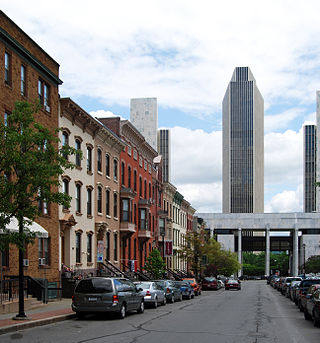
Albany is the capital city of the U.S. state of New York and the seat of Albany County. It is located on the west bank of the Hudson River, about 10 miles (16 km) south of its confluence with the Mohawk River, and about 135 miles (220 km) north of New York City.

The Archdiocese of New York is a Latin Church ecclesiastical territory or archdiocese of the Catholic Church located in the State of New York. It encompasses the boroughs of Manhattan, the Bronx and Staten Island in New York City and the counties of Dutchess, Orange, Putnam, Rockland, Sullivan, Ulster, and Westchester to the north of the city. It does not include Brooklyn and Queens, which are part of the Diocese of Brooklyn.

The Basilica-Cathedral of St. John the Baptist in St. John's, Newfoundland and Labrador is the metropolitan cathedral of the Roman Catholic Archdiocese of St. John's, Newfoundland and the mother church and symbol of Roman Catholicism in Newfoundland. The building sits within the St. John's Ecclesiastical District, a National Historic District of Canada.

The Diocese of Albany is a Latin Church diocese in eastern New York in the United States. Its mother church is the Cathedral of the Immaculate Conception in Albany.

The Cathedral of the Immaculate Conception is a Catholic church near the Mansion District in Albany, New York, United States. Built in the period of the 1848-1852, it is the mother church of the Diocese of Albany. In 1976 it was listed on the National Register of Historic Places.

St. Mary's Church is a Roman Catholic house of worship on Lodge Street in downtown Albany, New York, United States. It is a brick structure with an Italian Romanesque Revival exterior. Built in the 1860s, it is the third church to house the oldest Catholic congregation not only in the city, but in all of upstate New York. In 1977, St. Mary's Church was listed on the National Register of Historic Places; it is also a contributing property to the Downtown Albany Historic District, listed several years later.

There are 75 properties listed on the National Register of Historic Places in Albany, New York, United States. Six are additionally designated as National Historic Landmarks (NHLs), the most of any city in the state after New York City. Another 14 are historic districts, for which 20 of the listings are also contributing properties. Two properties, both buildings, that had been listed in the past but have since been demolished have been delisted; one building that is also no longer extant remains listed.

Arbor Hill is a neighborhood in Albany, New York, generally defined as the area from Clinton Avenue north to Tivoli Hollow and the Livingston Avenue Railroad Bridge and from Broadway west to Henry Johnson Boulevard. Both Clinton Avenue and Henry Johnson Boulevard are signed as U.S. Route 9. It was outside Albany's first boundaries as set up in the Dongan Charter of 1686. The original name of the area was Colonie, and the area was incorporated under that name as a village in 1804; it was annexed by Albany in 1815. There are two sub-neighborhoods in Arbor Hill, Dudley Heights and the Ten Broeck Triangle. "Arbor Hill" was the name given to the Ten Broeck estate; the Ten Broeck Mansion is still an important cultural and historical museum. The neighborhood has other historical and cultural sights such as the Palace Theatre and St. Joseph's Church. Demographically it is predominantly African-American.

The area of New York's Capital District, also known as the Albany metropolitan area, has seen prominent historical events, artistic creations, and unique contributions to the culture of the United States since the 17th century. The largest city in the area, Albany, consistently ranks high on lists of top cities/metro areas for culture, such as being 23rd in the book Cities Ranked & Rated. The Albany-Schenectady-Troy metro area ranked 12th among large metro areas, and Glens Falls ranked 12th among the small metro areas, in Sperling's Best Places, and Expansion Management gave the Albany-Schenectady-Troy area five Stars, its highest ranking, for quality of life features.

Wellington Row is a row of buildings along the south side of State Street in Albany, New York. It spans from 132 to 140 State Street and includes the Wellington Hotel, its namesake, the former Elks Lodge No. 49, former Berkshire Hotel, and a couple of row houses south of the Wellington Hotel. The Wellington Hotel included a second building called the Wellington Annex on Howard Street with an attached garage that both faced towards the back of Wellington Row. The row was placed on the Preservation League of New York State's Seven to Save list for the year 2000. The entire row is part of the Downtown Albany Historic District.

The architecture of Albany, New York, embraces a variety of architectural styles ranging from the early 18th century to the present. The city's roots date from the early 17th century and few buildings survive from that era or from the 18th and early 19th century. The completion of the Erie Canal in 1825 triggered a building boom, which continued until the Great Depression and the suburbanization of the area afterward. This accounts for much of the construction in the city's urban core along the Hudson River. Since then most construction has been largely residential, as the city spread out to its current boundaries, although there have been some large government building complexes in the modernist style, such as Empire State Plaza, which includes the Erastus Corning Tower, the tallest building in New York outside of New York City.

North Albany is a neighborhood in the city of Albany, New York. North Albany was settled in the mid-17th century by the Patroon of Rensselaerswyck and his tenants and later became a hamlet in the town of Watervliet. Due to the Erie Canal being constructed in 1825, North Albany saw immense growth, with the Albany Lumber District and an influx of Irish immigrants lending the area the name of Limerick. Home to many historic warehouses and row houses, North Albany continues to be an important industrial neighborhood. Recent efforts have begun to gentrify the neighborhood by adapting heavy industry/warehouse use to artistic and entertainment venues, such as a German beer garden, an amusement park, live music venues, and arts and crafts marketplaces.
Pine Hills is a neighborhood in Albany, New York, generally defined as the area from Manning Boulevard to the west, Woodlawn Avenue to the south, Lake Avenue to the east, and Washington Avenue to the north. The neighborhood consists mainly of freestanding multi-unit, duplex, and semi-detached houses and is home to Albany High School, the LaSalle school, the College of St. Rose, and the Alumni Quad of the University at Albany. Though mostly residential due to historical reasons from its founding, Pine Hills is home to two neighborhood commercial districts ; Middle Madison, from Partridge to Quail streets was designated first, and then a latter designated district, Upper Madison, from Main Avenue to North Allen Street. The area of Pine Hills east of Main Avenue and north of Myrtle Avenue is commonly referred to as the student ghetto due to its predominant population of college-age students. The area of Pine Hills west of Main Avenue features many large Queen Anne, Folk Victorian, and Colonial Revival homes. Upper Madison, where it meets Western Avenue near St. Rose is the center of a commercial area, complete with a movie theater, grocery store, fast food strip mall, retail, restaurants, a library, community playhouse, police station, pharmacy, and elementary school.

Sheridan Hollow is a neighborhood in Albany, New York located in a ravine north of Downtown Albany. Capitol Hill to the south and Arbor Hill to the north flank the ravine. Often the neighborhood is overlooked by city residents, and outsiders who work in the neighborhood often don't recognize the name of the neighborhood. This is due to the identity of the Hollow being subsumed into its larger neighbor Arbor Hill, for instance news stories of events are often accredited to the wrong neighborhood. Being on undesirable land for development in colonial times, growth was slow in the Hollow and the neighborhood was populated through the centuries by a series of ethnic groups new to Albany, such as the Irish, Polish, and African Americans.

The Arbor Hill Historic District–Ten Broeck Triangle, originally the Ten Broeck Historic District, is a seven-block area located within the Arbor Hill neighborhood north of what is today downtown Albany, New York, United States. In 1979 its easternmost third, the Ten Broeck Triangle, the second oldest residential neighborhood in the city, was recognized as a historic district and listed on the National Register of Historic Places. Four years later, the district was increased to its current size and renamed to reflect its expansion to include some of the rest of Arbor Hill.

Lincoln Park is an urban park in Albany, New York, with a unique history, from being the site of a skirmish in 1626 between the Dutch and Mohawks to brickyards and breweries to being Albany's first public playground. The park features Albany's only outdoor non-wading swimming pool, along with several tennis courts, basketball courts, and football and baseball fields. Within the park is the James Hall Office, a National Historic Landmark, and the Thomas O'Brien Academy of Science and Technology (TOAST) an elementary school.

Tricentennial Park is an urban park in Albany, New York built to commemorate that city's three hundredth anniversary as an incorporated city and is the site of several statues and monuments. The park encompasses the entire block bounded by Broadway to the east, Columbia Street to the north, James Street to the west, and Steuben Street to the south. First proposed in 1914 it was built in 1986 as part of the tricentennial celebrations of Albany's incorporation as a city in association with the renovation of the Albany Union Station.

Bleecker Park is a small .37-acre (0.15 ha) urban park in Albany, New York. The park is triangle-shaped, bounded by Madison Place to the south, Madison Avenue to the north, and Eagle Street to the west. The Cathedral of Immaculate Conception is across Eagle Street from the park, while Madison Place, which is only one block-long, consists of rowhouses primarily in High Gothic and Italianate architecture, built in the mid-to-late-19th century. Across from the park on Madison Street is the Empire State Plaza East Parking Garage, built in 1999/2000. The park features the oldest fountain in the city which is surrounded by a small circular garden, two circular beds are also in the park and each feature a shrub surrounded flowers, these small gardens make Bleecker Park "a most charming and restrained Victorian public garden" according to an article in the Albany Times Union.

St Dominic's Church, formerly St Dominic's Priory Church, is a Roman Catholic Parish church in Newcastle-upon-Tyne. It was built from 1869 and opened in 1873. It was founded by the Dominican Order. It is located on New Bridge Street, east of Manors railway station, in the Ouseburn area of Newcastle. It was designed by Archibald Matthias Dunn and is a Grade II listed building.






















